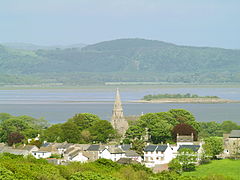Bardsea
| Bardsea | |
|---|---|
 Bardsea Village with Chapel Island |
|
| Bardsea shown within Cumbria | |
| OS grid reference | SD303732 |
| Civil parish | |
| District | |
| Shire county | |
| Region | |
| Country | England |
| Sovereign state | United Kingdom |
| Post town | ULVERSTON |
| Postcode district | LA12 |
| Dialling code | 01229 |
| Police | Cumbria |
| Fire | Cumbria |
| Ambulance | North West |
| EU Parliament | North West England |
| UK Parliament | |
Bardsea is a village in the Low Furness area of Cumbria, England. It is two miles to the south-east of Ulverston on the northern coast of Morecambe Bay. It lies within the historic borders of Lancashire.
Bardsea, or Berretseige, is mentioned in the Domesday Book as one of the townships forming the Manor of Hougun held by Earl Tostig. Also once part of the medieval manor of Muchland.
Bardsea was a small farming and fishing village well into the 19th century. It was accessed mainly by crossing the treacherous sands of Morecambe Bay. The church of Holy Trinity was consecrated in 1853: previously the area had been included within the parish of Urswick.
The area was also associated with the early Quaker movement; when founder George Fox married local landowner Margaret Fell, he took over Swarthmoor Hall and much of the land round Bardsea. There is an old Quaker burial ground nearby at Sunbrick on Birkrigg Common, where Margaret Fell was reputedly buried in 1702 (one authority suggests she was interred at the burial ground at Swarthmoor, although this is contradicted by other sources). George Fox himself was buried in London.
When iron ore mining and production led to industrialization in Furness, Bardsea became an important port, with steamers leaving for Fleetwood and Liverpool. This was short-lived, however, with the Furness Railway and Ulverston Canal taking business away from the village by the late end of the Victorian period.
...
Wikipedia

